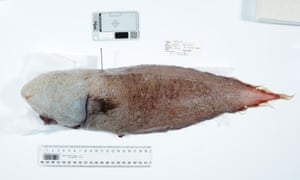Expedition leader says the deep-sea fish had not been seen in waters off Australia since 1873
A “faceless” deep-sea fish not seen for more than a century has been rediscovered by scientists trawling the depths of a massive abyss off Australia’s east coast, along with “amazing” quantities of rubbish.
The 40cm fish was rediscovered 4km below sea level in waters south of Sydney by scientists from Museums Victoria and the Australian government’s Commonwealth Scientific and Industrial Research Organisation (CSIRO) on the weekend.
Dr Tim O’Hara, the chief scientist and expedition leader, who is a senior curator of marine invertebrates at Museums Victoria, said it was the first time the fish had been seen in waters off Australia since 1873, when one was dredged up by a British ship near Papua New Guinea.
“This little fish looks amazing because the mouth is actually situated at the bottom of the animal so, when you look side-on, you can’t see any eyes, you can’t see any nose or gills or mouth,” O’Hara said via satellite phone from the research vessel Investigator on Wednesday. “It looks like two rear-ends on a fish, really.”
The world-first survey of commonwealth marine reserves stretching from northern Tasmania to central Queensland began on 15 May. On board the Investigator research vessel for the month-long voyage are 27 scientists, 13 technicians and 20 crew.
Samples of animals and sediment have been collected from the bottom of the abyss each day by a metal sled-style device attached to 8km of thick wire. A video camera has also been trailed behind the ship to capture footage from the depths.
Finds have included bright red spiky rock crabs, spectacular bioluminescent sea stars and gigantic sea spiders as big as a dinner plate.
“The experts tell me that about a third of all specimens coming on board are new totally new to science,” O’Hara said. “They aren’t all as spectacular as the faceless fish but there’s a lot of sea fleas and worms and crabs and other things that are totally new and no one has seen them ever before.”
Di Bray of Museums Victoria told the ABC that the rediscovery of the faceless fish was a highlight of the “awesome stuff” thrown up by the study so far.
“On the video camera we saw a kind of chimaera that whizzed by – that’s very, very rare in Australian waters,” she said. “We’ve seen a fish with photosensitive plates that sit on the top of its head, tripod fish that sit up on their fins and face into the current.”

“A lot” of the species found would prove to be previously undiscovered, she predicted.
“We’re not even scratching the surface of what we know about our abyssal plain fishes.”
Equally “amazing”, O’Hara said, was the quantity of rubbish that researchers had dredged up.
“There’s a lot of debris, even from the old steam ship days when coal was tossed overboard,” he said. “We’ve seen PVC pipes and we’ve trawled up cans of paints.
“It’s quite amazing. We’re in the middle of nowhere and still the sea floor has 200 years of rubbish on it.”
In February, scientists reported “extraordinary” levels of toxic pollution in the 10km-deep Mariana trench, one of the most remote and inaccessible places on the planet.
Data from the survey of the eastern abyss would allow scientists to collect baseline data about its biodiversity and would likely be used to measure the impacts of climate change in the coming decades.
The research voyage is due to conclude on 16 June.
Source: The Guardian

































Leave a Comment
You must be logged in to post a comment.